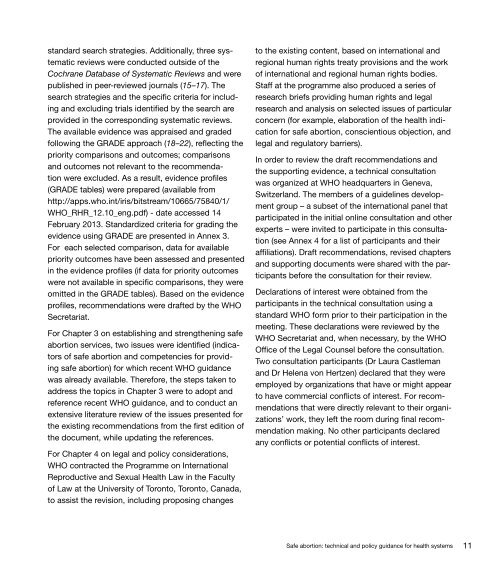Safe abortion:
Safe abortion:
Safe abortion:
Create successful ePaper yourself
Turn your PDF publications into a flip-book with our unique Google optimized e-Paper software.
standard search strategies. Additionally, three systematic<br />
reviews were conducted outside of the<br />
Cochrane Database of Systematic Reviews and were<br />
published in peer-reviewed journals (15–17). The<br />
search strategies and the specific criteria for including<br />
and excluding trials identified by the search are<br />
provided in the corresponding systematic reviews.<br />
The available evidence was appraised and graded<br />
following the GRADE approach (18–22), reflecting the<br />
priority comparisons and outcomes; comparisons<br />
and outcomes not relevant to the recommendation<br />
were excluded. As a result, evidence profiles<br />
(GRADE tables) were prepared (available from<br />
http://apps.who.int/iris/bitstream/10665/75840/1/<br />
WHO_RHR_12.10_eng.pdf) - date accessed 14<br />
February 2013. Standardized criteria for grading the<br />
evidence using GRADE are presented in Annex 3.<br />
For each selected comparison, data for available<br />
priority outcomes have been assessed and presented<br />
in the evidence profiles (if data for priority outcomes<br />
were not available in specific comparisons, they were<br />
omitted in the GRADE tables). Based on the evidence<br />
profiles, recommendations were drafted by the WHO<br />
Secretariat.<br />
For Chapter 3 on establishing and strengthening safe<br />
<strong>abortion</strong> services, two issues were identified (indicators<br />
of safe <strong>abortion</strong> and competencies for providing<br />
safe <strong>abortion</strong>) for which recent WHO guidance<br />
was already available. Therefore, the steps taken to<br />
address the topics in Chapter 3 were to adopt and<br />
reference recent WHO guidance, and to conduct an<br />
extensive literature review of the issues presented for<br />
the existing recommendations from the first edition of<br />
the document, while updating the references.<br />
For Chapter 4 on legal and policy considerations,<br />
WHO contracted the Programme on International<br />
Reproductive and Sexual Health Law in the Faculty<br />
of Law at the University of Toronto, Toronto, Canada,<br />
to assist the revision, including proposing changes<br />
to the existing content, based on international and<br />
regional human rights treaty provisions and the work<br />
of international and regional human rights bodies.<br />
Staff at the programme also produced a series of<br />
research briefs providing human rights and legal<br />
research and analysis on selected issues of particular<br />
concern (for example, elaboration of the health indication<br />
for safe <strong>abortion</strong>, conscientious objection, and<br />
legal and regulatory barriers).<br />
In order to review the draft recommendations and<br />
the supporting evidence, a technical consultation<br />
was organized at WHO headquarters in Geneva,<br />
Switzerland. The members of a guidelines development<br />
group – a subset of the international panel that<br />
participated in the initial online consultation and other<br />
experts – were invited to participate in this consultation<br />
(see Annex 4 for a list of participants and their<br />
affiliations). Draft recommendations, revised chapters<br />
and supporting documents were shared with the participants<br />
before the consultation for their review.<br />
Declarations of interest were obtained from the<br />
participants in the technical consultation using a<br />
standard WHO form prior to their participation in the<br />
meeting. These declarations were reviewed by the<br />
WHO Secretariat and, when necessary, by the WHO<br />
Office of the Legal Counsel before the consultation.<br />
Two consultation participants (Dr Laura Castleman<br />
and Dr Helena von Hertzen) declared that they were<br />
employed by organizations that have or might appear<br />
to have commercial conflicts of interest. For recommendations<br />
that were directly relevant to their organizations’<br />
work, they left the room during final recommendation<br />
making. No other participants declared<br />
any conflicts or potential conflicts of interest.<br />
<strong>Safe</strong> <strong>abortion</strong>: technical and policy guidance for health systems 11


